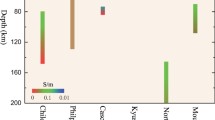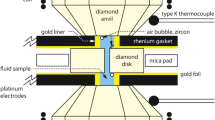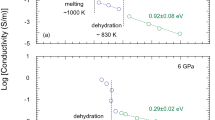Abstract
The electrical conductivity of phyllite (measured in situ at 0.5–2.5 GPa and 773–1173 K) increases with increasing temperature, satisfying an Arrhenius relation. Dehydration of phyllite at 973–1173 K enormously enhances its electrical conductivity, and the activation enthalpy (0.64–0.81 eV) remains almost constant before and after dehydration. The inflection point of the relationship between electrical conductivity and temperature is used to determine the dehydration temperature (T d ) at each considered pressure (P), leading to the following relationship: T d = 1181 − 100P. The derived relation implies that the dehydration depths of hot and cold subduction zones are ~70 and ~129 km respectively, which are both close to the depths of arc magma source regions, thereby indicating that the dehydration of pelite significantly influences the generation of melt in subduction zones.










Similar content being viewed by others
References
Ahrens TJ (1989) Water storage in the mantle. Nature 342:122–123
Bebout GE, Penniston-Dorland SC (2016) Fluid and mass transfer at subduction interfaces − The field metamorphic record. Lithos 240-243:228–258
Cabral AR, Wiedenbeck M, Koglin N, Lehmann B, Abreu FRD (2012) Boron-isotopic constraints on the petrogenesis of hematitic phyllite in the southern Serra do Espinhaco, Minas Gerais, Brazil. Lithos 140:224–233
Cherevatova M, Smirnov M, Korja T, Kaikkonen P, Pedersen LB, Hübert J, Kamm J, Kalscheuer T (2014) Crustal structure beneath southern Norway imaged by magnetotellurics. Tectonophysics 628:55–70
Dai LD, Karato SI (2009a) Electrical conductivity of wadsleyite at high temperatures and high pressures. Earth Planet Sci Lett 287:277–283
Dai LD, Karato SI (2009b) Electrical conductivity of pyrope-rich garnet at high temperature and high pressure. Phys Earth Planet Inter 176:83–88
Dai LD, Karato SI (2014a) High and highly anisotropic electrical conductivity of the asthenosphere due to hydrogen diffusion in olivine. Earth Planet Sci Lett 408:79–86
Dai LD, Karato SI (2014b) The effect of pressure on the electrical conductivity of olivine under the hydrogen-rich conditions. Phys Earth Planet Inter 232:51–56
Dai LD, Karato SI (2014c) Influence of oxygen fugacity on the electrical conductivity of hydrous olivine: implications for the mechanism of conduction. Phys Earth Planet Inter 232:57–60
Dai LD, Karato SI (2014d) Influence of FeO and H on the electrical conductivity of olivine. Phys Earth Planet Inter 237:73–79
Dai LD, Li HP, Hu HY, Shan SM (2008) Experimental study of grain boundary electrical conductivities of dry synthetic peridotite under high-temperature, high-pressure, and different oxygen fugacity conditions. J Geophys Res 113:B12211
Dai LD, Li HP, Hu HY, Shan SM (2009) Novel technique to control oxygen fugacity during high-pressure measurements of grain boundary conductivities of rocks. Rev Sci Instrum 80:033903
Dai LD, Li HP, Hu HY, Shan SM, Jiang JJ, Hui KS (2012) The effect of chemical composition and oxygen fugacity on the electrical conductivity of dry and hydrous garnet at high temperatures and pressures. Contrib Mineral Petrol 163:689–700
Dai LD, Li HP, Hu HY, Jiang JJ, Hui KS, Shan SM (2013) Electrical conductivity of Alm82Py15Grs3 almandine-rich garnet determined by impedance spectroscopy at high temperatures and high pressures. Tectonophysics 608:1086–1093
Dai LD, Hu HY, Li HP, Jiang JJ, Hui KS (2014) Influence of temperature, pressure, and chemical composition on the electrical conductivity of granite. Am Mineral 99:1420–1428
Dai LD, Hu HY, Li HP, Hui KS, Jiang JJ, Li J, Sun WQ (2015) Electrical conductivity of gabbro: the effects of temperature, pressure and oxygen fugacity. Eur J Mineral 27:215–224
Dai LD, Hu HY, Li HP, Wu L, Hui KS, Jiang JJ, Sun WQ (2016) Influence of temperature, pressure, and oxygen fugacity on the electrical conductivity of dry eclogite, and geophysical implications. Geochem Geophys Geosyst 17:2394–2407
Duba AG, Shankland TJ (1982) Free carbon and electrical conductivity in the Earth’s mantle. Geophys Res Lett 9:1271–1274
Fuji-ta K, Katsura T, Tainosho Y (2004) Electrical conductivity measurement of granulite under mid- to lower crustal pressure-temperature conditions. Geophys J Int 157:79–86
Fuji-ta K, Katsura T, Matsuzaki T, Ichiki M (2007a) Electrical conductivity measurements of brucite under crustal pressure and temperature conditions. Earth Planets Space 59:645–648
Fuji-ta K, Katsura T, Matsuzaki T, Ichiki M, Kobayashi T (2007b) Electrical conductivity measurement of gneiss under mid- to lower crustal P-T conditions. Tectonophysics 434:93–101
Gaillard F, Malki M, Iacono-Marziano G, Pichavant M, Scaillet B (2008) Carbonatite melts and electrical conductivity in the asthenosphere. Science 322:1363–1365
Hicks TL, Secco RA (1997) Dehydration and decomposition of pyrophyllite at high pressures: electrical conductivity and X-ray diffraction studies to 5 GPa. Can J Earth Sci 34:875–882
Hu HY, Li HP, Dai LD, Shan SM, Zhu CM (2013) Electrical conductivity of alkali feldspar solid solutions at high temperatures and high pressures. Phys Chem Miner 40:51–62
Hu HY, Dai LD, Li HP, Jiang JJ, Hui KS (2014) Electrical conductivity of K-feldspar at high temperature and high pressure. Mineral Petrol 108:609–618
Hu HY, Dai LD, Li HP, Jiang JJ, Hui KS, Li J (2015) Temperature and pressure dependence of electrical conductivity in synthetic anorthite. Solid State Ionics 276:136–141
Huang XG, Xu YS, Karato S (2005) Water content in the transition zone from electrical conductivity of wadsleyite and ringwoodite. Nature 434:746–749
Huebner JS, Dillenburg RG (1995) Impedance spectra of hot, dry silicate minerals and rock-qualitative interpretation of spectra. Am Mineral 80:46–64
Hyndman RD, Vanyan LL, Marquis G (1993) The origin of electrically conductive lower continental crust: saline water or graphite? Phys Earth Planet Inter 81:325–344
Li Y, Tang HF, Liu CQ, Hou GS (2005) The high pressure differential thermal study of dehydration effect of pelite. Acta Petrol Sin 21:986–992 (in Chinese)
Li Y, Yang XZ, Yu JH, Cai YF (2016) Unusually high electrical conductivity of phlogopite: the possible role of fluorine and geophysical implications. Contrib Mineral Petrol 171:1–11
Macdonald JR (1992) Impedance spectroscopy. Ann Biomed Eng 20:289–305
Manthilake M, Matsuzaki T, Yoshino T, Yamashita S, Ito E, Katsura T (2009) Electrical conductivity of wadsleyite as a function of temperature and water content. Phys Earth Planet Inter 174:10–18
Manthilake G, Mookherjee M, Bolfan-Casanova N (2015) Electrical conductivity of lawsonite and dehydrating fluids at high pressures and temperatures. Geophys Res Lett 42:7398–7405
Manthilake G, Bolfan-Casanova N, Novella D, Mookherjee M, Andrault D (2016) Dehydration of chlorite explains anomalously high electrical conductivity in the mantle wedges. Sci Adv 2:e1501631
Maumus J, Bagdassarov N, Schmeling H (2005) Electrical conductivity and partial melting of mafic rocks under pressure. Geochim Cosmochim Acta 69:4703–4718
Micheuz P, Krenn K, Fritz H, Kurz W (2015) Tectonometamorphic evolution of blueschist-facies rocks in the phyllite-quartzite unit of the external hellenides (Mani, Greece). Austrian J Earth Sci 108:109–122
Nover G, Will G, Waitz R (1992) Pressure-induced phase-transition in Mg2GeO4 as determined by frequency-dependent complex electrical-resistivity measurements. Phys Chem Miner 19:133–139
Ogawa Y, Nishida Y, Makino M (1994) A collision boundary imaged by magnetotellurics, Hidaka mountains, Central Hokkaido, Japan. J Geophys Res 99:22373–22388
Peacock SM (1990) Numerical simulation of metamorphic pressure- temperature- time paths and fluid production in subducting slabs. Tectonics 9:1197–1211
Rao CK, Selvaraj C, Gokarn SG (2014) Deep electrical structure over the igneous arc of the indo Burman Orogen in Sagaing province, Myanmar from magnetotelluric studies. J Asian Earth Sci 94:68–76
Reynard B, Mibe K, Van de Moortele B (2011) Electrical conductivity of the serpentinised mantle and fluid flow in subduction zones. Earth Planet Sci Lett 307:387–394
Roberts JJ, Tyburczy JA (1991) Frequency dependent electrical properties of polycrystalline olivine compacts. J Geophys Res 96:16205–16222
Robertson K, Taylor D, Thiel S, Heinson G (2015) Magnetotelluric evidence for serpentinisation in a Cambrian subduction zone beneath the Delamerian Orogen, Southeast Australia. Gondwana Res 28:201–211
Satoh H, Nishida Y, Utsugi M, Hirano K, Doi T, Arita K (1998) Resistivity structure in and around the southern part of Hidaka Metamorphic Belt, Hokkaido, as inferred from magnetotelluric investigations. Geophys Bull Hokkaido Univ 61:59–68 (in Japanese)
Saunders AD, Norry MJ, Tarney J (1991) Fluid influence on the trace element compositions of subduction zone magmas. Philos T Roy Soc A 335:377–392
Schilling FR, Partzsch GM, Brasse H, Schwarz G (1997) Partial melting below the magmatic arc in the Central Andes deduced from geoelectromagnetic field experiments and laboratory data. Phys Earth Planet Inter 103:17–31
Shatskiy A, Litasov K, Matsuzaki T, Shinoda K, Yamazaki D, Yoneda A, Ito E, Katsura T (2009) Single crystal growth of wadsleyite. Am Mineral 94:1130–1136
Song MS, Xie HS, Zheng HF, Guo J, Xu YS, Xu ZM (1996) Determination of serpentine dehydration temperature at 1–5 GPa by the method of electrical conductivity. Chin Sci Bull 41:1815–1819
Spandler C, Pirard C (2013) Element recycling from subducting slabs to arc crust: a review. Lithos 170-171:208–223
Tatsumi Y (1989) Migration of fluid phases and genesis of basalt magmas in subduction zones. J Geophys Res 94:4697–4707
Tatsumi Y, Eggins S (1995) Subduction zone magmatism. Blackwell Science, Cambridge, pp 100–105
Wyllie PJ (1982) Subduction products according to experimental prediction. Bull Geol Soc Am 93:468–476
Xie HS, Zhou WG, Zhu MX, Liu YG (2002) Elastic and electrical properties of serpentinite dehydration at high temperature and high pressure. J Phys-Condens Mat 14:11359–11363
Yang XZ (2012) Orientation-related electrical conductivity of hydrous olivine, clinopyroxene and plagioclase and implications for the structure of the lower continental crust and uppermost mantle. Earth Planet Sc Lett 317-318:241–250
Yang XZ, McCammon C (2012) Fe3+-rich augite and high electrical conductivity in the deep lithosphere. Geology 40:131–134
Yang XZ, Keppler H, McCammon C, Ni HW, Xia QK, Fan QC (2011) Effect of water on the electrical conductivity of lower crustal clinopyroxene. J Geophys Res 116:B04208
Yang XZ, Keppler H, McCammon C, Ni HW (2012) Electrical conductivity of orthopyroxene and plagioclase in the lower crust. Contrib Mineral Petrol 163:33–48
Yoshino T, Laumonier M, Mcisaac E, Katsura T (2010) Electrical conductivity of basaltic and carbonatite melt-bearing peridotites at high pressures: implications for melt distribution and melt fraction in the upper mantle. Earth Planet Sc Lett 295:593–602
Zhang LT, Unsworth M, Jin S, Wei W, Ye GF, Jones AG, Jing JN, Dong H, Xie CL, Pape FL, Vozar J (2015) Structure of the central Altyn Tagh fault revealed by magnetotelluric data: new insights into the structure of the northern margin of the India-Asia collision. Earth Planet Sc Lett 415:67–79
Zhao ZF, Dai LQ, Zheng YF (2015) Two types of the crust-mantle interaction in continental subduction zones. Sci China Ser D 58:1269–1283
Zhu MX, Xie HS, Guo J, Zhang YM, Xu ZM (1999) Electrical conductivity measurement of serpentine at high temperature and pressure. Chin Sci Bull 44:1903–1907
Zhu MX, Xie HS, Guo J, Bai WM, Xu ZM (2001) Impedance spectroscopy analysis on electrical properties of serpentine at high pressure and high temperature. Sci China Ser D 44:336–345
Acknowledgements
Constructive reviews of two anonymous experts are gratefully acknowledged. This research was financially supported by the Strategic Priority Research Program (B) of the Chinese Academy of Sciences (XDB 18010401), Key Research Projects of the Frontier Science of the Chinese Academy of Sciences (QYZDB-SSW-DQC009), “135” Program of the Institute of Geochemistry of CAS, Hundred Talents Program of CAS, Youth Innovation Promotion Association of CAS, NSF of China (41474078, 41304068 and 41174079) and Open Foundation of Institute of Geology and Geophysics of CAS.
Author information
Authors and Affiliations
Corresponding author
Additional information
Editorial handling: M.A.T.M. Broekmans
Rights and permissions
About this article
Cite this article
Sun, W., Dai, L., Li, H. et al. Effect of dehydration on the electrical conductivity of phyllite at high temperatures and pressures. Miner Petrol 111, 853–863 (2017). https://doi.org/10.1007/s00710-017-0494-2
Received:
Accepted:
Published:
Issue Date:
DOI: https://doi.org/10.1007/s00710-017-0494-2




